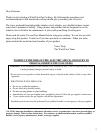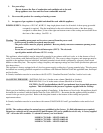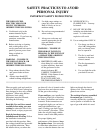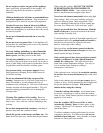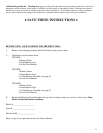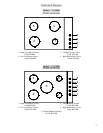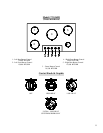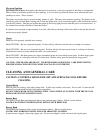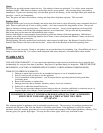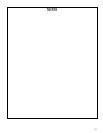5
Do not repair or replace any part of the appliance
unless specifically recommended in this manual. All
other servicing should be referred to a qualified
technician.
Children should not be left alone or unattended in an
area where appliances are in use. They should never
be allowed to sit or stand on any part of the appliance.
Caution: Do not store items of interest to children
above the cooktop or at the back. If children should
climb onto the appliance to reach these items, they could
be seriously injured.
Do not store flammable materials on or near the
cooktop.
Do not use water on grease fires. Turn appliance off
and smother fire with baking soda or use a dry chemical
or foam-type extinguisher.
Never let clothing, potholders, or other flammable
materials come in contact with the burners or the
burner grates, until they are cool to the touch.
Use only dry potholders; moist or damp potholders on
hot surfaces may cause burns from steam. Do not use a
towel or other bulky cloth in place of potholders. Do not
let potholders touch hot burners or burner grates.
For personal safety, wear proper apparel. Loose
fitting garments or hanging sleeves should never be
worn while cooking.
Do not use aluminum foil to line any part of the
cooktop. Improper use of a foil liner could result in a
shock, fire hazard or it could obstruct the flow of
combustion and ventilation air. Foil is an excellent heat
insulator and heat will be trapped beneath it. This will
upset the cooking performance and can damage the
cooktop finish.
Warning: The appliance is for cooking. Based on
safety considerations never use the cooktop to warm or
heat a room. Also, such use could be damaging to the
cooktop.
Do not heat unopened food containers; a buildup of
pressure may cause the container to burst.
Match the pot size to the burner and flame size. The
flame should be equal to or smaller than the pan bottom.
When using the cooktop: DO NOT TOUCH THE
BURNER GRATES OR THE IMMEDIATE
SURROUNDING AREA. Areas adjacent to the
burners may become hot enough to cause burns.
Never leave the burners unattended when using high
flame settings. Boil overs cause smoking and greasy
spillovers that may ignite. More importantly, if the
flame is smothered, unburned gas will be coming into
the room. See “What to do if you smell gas,” page 2.
Always use utensils that have flat bottoms. Hold the
handle of the pan to prevent movement of the utensil
when stirring or turning food.
To minimize burns, ignition of flammable materials, and
unintentional spillovers, position handles of utensils so
that they do not extend over adjacent work areas,
burners, or the edge of the cooktop.
During cooking, set the burner control so that the
flame heats only the bottom of the pan and does not
extend beyond the edge of the pan.
Only certain types of glass, heat-proof glass-ceramic,
ceramic, earthenware, or other glazed utensils are
suitable for cooktop use. This type of utensil may
break with sudden temperature changes. Use only on
low or medium flame settings according to
manufacturer’s directions.
If the cooktop is near a window, be certain the curtains
do not blow over or near the burners; they could catch
on fire.
In the event a burner goes out and gas escapes, open a
window or door. Do not attempt to use the cooktop until
the gas has had time to dissipate. Wait at least 5
minutes before using the cooktop.
Clean the cooktop with caution. Avoid steam burns;
do not use a wet sponge or cloth to clean the cooktop
while it is hot. Some cleaners produce noxious fumes if
applied to a hot surface.
Turn the ventilator OFF in case of fire or when
intentionally “flaming” liquor or other spirits on the
cooktop. The blower, if in operation, could unsafely
spread the flames.
To achieve optimum cooking performance do not use
warped pots and pans. For safety reasons do not use
unbalanced pots and pans – heavy handles or warped
bottoms can cause pans to be unstable




